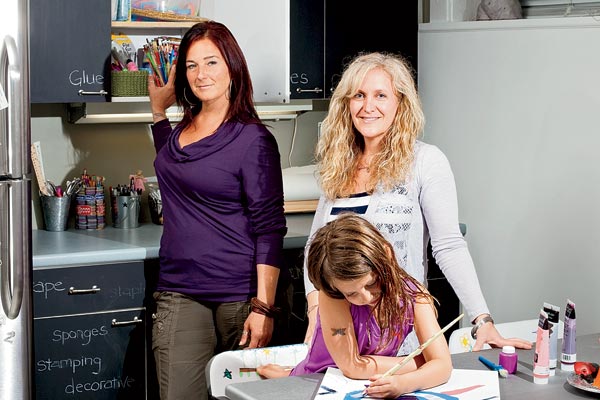
Paula Anast (left) helped Rebecca Finkelstein (with daughter, Hannah).
Related:
MORE BY JEFF RUBY
Inside the Mind of an Art Institute Guard »
Chicago Restaurant Critics Talk Food Fights »
Finding the Perfect Bike in Chicago »
Barack Obama, Next-Door Neighbor »
Are Police Sketch Artists Becoming Obsolete? »
Facing His 40th Birthday, A Chicago Man Runs 40 Races »
Meet the Doughnut-Craziest Family in Chicago »
A Desperate Man Road-Tests Trunk Club »
Following a Freak Accident, a Father Faces a Grueling Choice »
Beer Tips From Steve Hamburg, Chicago’s Cask King »
Mutt Versus Jeff: One Animal-Ignorer’s Experience with the Wild New Family Dog »
Anonymous Restaurant Reviewing: Journalistic Gold Standard or Antiquated Parlor Game? »
Lousy Parenting: One Family’s Experience with Head Lice Removal »
She knew she had a problem, because she’d been dragging it around for so long that it filled the basement of her 4,400-square-foot Queen Anne Victorian in Evanston. When she had moved four years ago, her mother and sister tried to get her to deal with it. Big fight. Tears.
Call it hoarding, sickness, or desperate nostalgia, but Rebecca Finkelstein couldn’t throw anything away. Not the notes from high-school English, the ball and jacks from summer camp, or the 1978 Young Miss with Shaun Cassidy on the cover. Certainly not the nightgown in which her mother birthed her. Professional movers call those unopened boxes that travel from home to home “dreck,” and Finkelstein had accumulated so much that she had to clear a path to walk through her basement. A contractor quoted $22,000 to rehab the space, and he would have just built a storage room and shoved the boxes inside. Finkelstein’s husband threatened to toss a box a week if she didn’t do something about the dread that lurked below.
Perhaps it was fate that a friend told Finkelstein about Paula Anast. A Bridgeport native who lives in Portland, Oregon, but commutes back here for clients, Anast charges $1,200 to $1,500 a week to purge and streamline a home. Perfect! An interior decorator by trade, she also haunts thrift stores for cheap solutions to transform your space and repurposes materials you’ve left for dead. Great. Oh, and she moves into your house. Terrif— Wait . . . she does what?
“If you’re going to organize someone’s life, you need to see how they live,” says Anast. When she saw Finkelstein’s dumping ground, her eyes widened—in excitement. A chance to dehoard and help a family who didn’t realize how much easier their lives could be! What could be better? Finkelstein also loved the idea. “We hire a guy to take care of our lawn and another to do our taxes,” she told her skeptical husband. “If we’re fortunate enough, why not do the same thing for our lives?” Anast moved into the basement and went to work.
Though the two women were born on the same day in 1970, they couldn’t be more different. Finkelstein is an early riser and a frenzied mother of three; Anast is single and unanchored, a night owl, and a former pastry chef, with a brain fixated on order. Their lack of shared history aided the process. Who wants to take advice from family? “It’s much easier to take it from strangers,” Anast says. “Especially when you’re paying them.” The pair spent weeks sifting through boxes, sorting and culling, turning big piles into smaller ones. Periodically, Anast would see something and think, Wow, I had this in fourth grade, too. I threw it out in fifth grade. But there was no judgment, no reminiscing. Just progress. Anast sometimes worked all night.
Meanwhile, Finkelstein’s husband fielded queries from friends about the arrangement: Where does she sleep? (On a rumpled blanket on the basement floor.) Does she eat with you? (She has her own fridge. But it’s not like we locked her down there.) Is she a hottie? (Shut up.)
The only thing more striking than the basement’s eight-week transformation—from a disaster zone into a funky art room and a children’s performance space, complete with theatre seats from the Brown Elephant in Wrigleyville—is the ease with which it happened. Finkelstein parted with 50 percent of her dreck; the other half is unpacked and organized in a way that makes perfect sense for the family’s needs. Anast has moved on to her next project: a house in Old Irving Park, where a stressed mother of three begged her, “Save me from this.”
And in a certain Queen Anne Victorian in Evanston, a weight has been lifted. Finkelstein swears she will not backslide—but her eight-year-old recently refused to throw out a stuffed banana doll he hadn’t touched in five years. “We can’t get rid of that!” he cried. “It has memories.”
Photograph: Anna Knott


